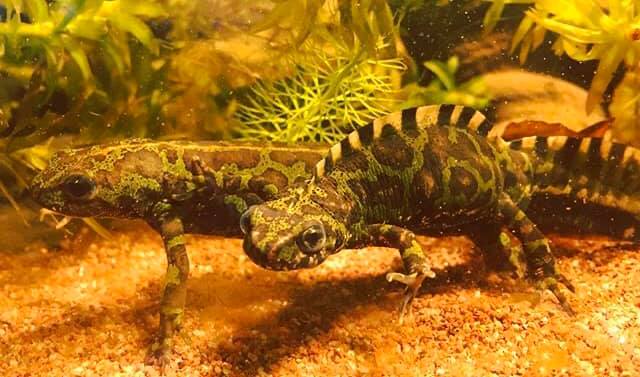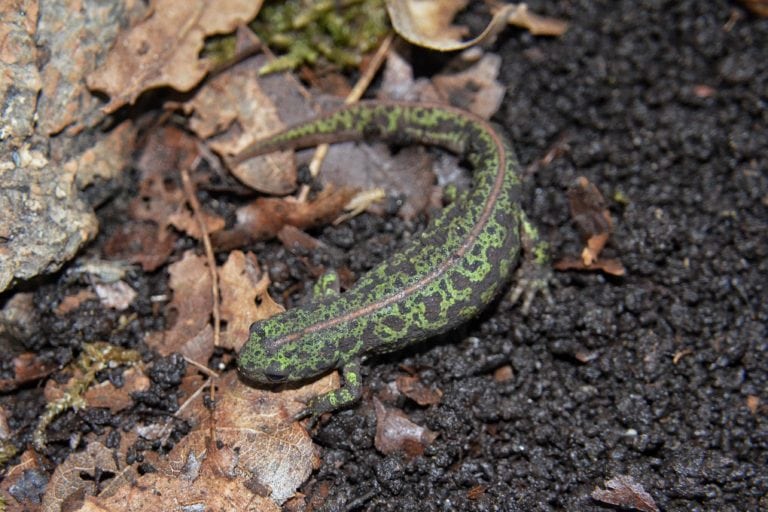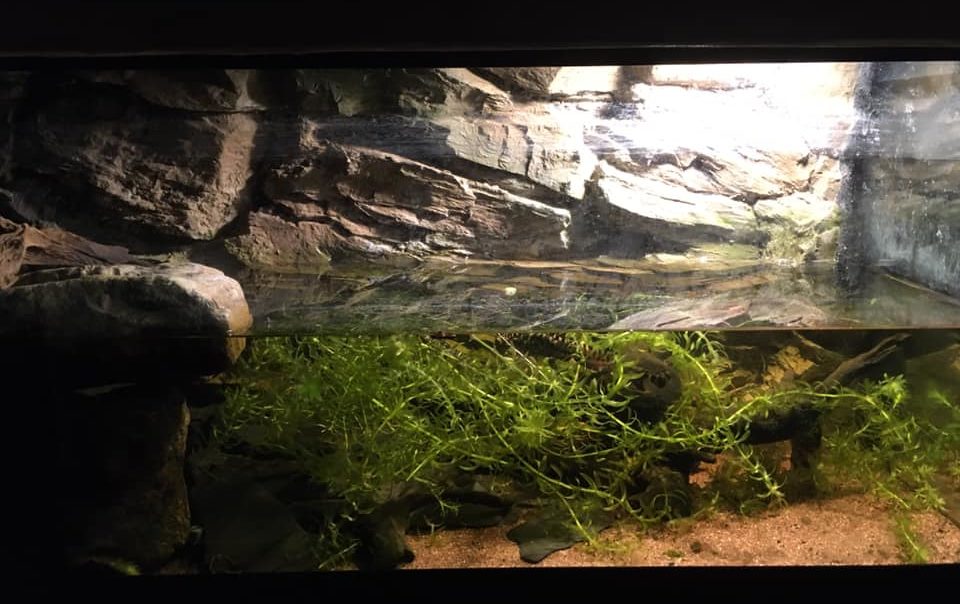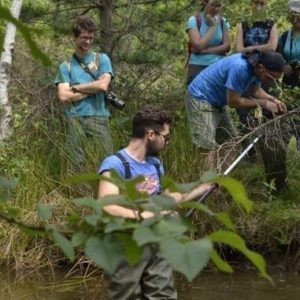Triturus marmoratus

Description:
The Triturus marmoratus is a specie which reaches the maximum length of 17cm (with the females being bigger than the males) and it is one of the bigger species of its genus. These newts have a fascinating colour pattern which makes them easily distinguishable from other species: on the back there is a characteristic green marbled pattern on black/brown background while the belly is black or cream colour with a variable number of white dots. Along the dorsal line, there is a orange line (from the base of the head to the tip of the tail) which in males becomes segmented with black spots, and it develops in a black and white banded crest during breeding season (females do not develop a crest, and the dorsal line remains a solid orange). The eye is black with an horizontal pupil and a green spot on the upper side of the iris.
The dorsal colouration visibly changes between terrestrial and aquatic animals, with the patter of the aquatic animals being less vivid and defined.
The males are easily distinguishable from the females mainly thanks to the development of the dorsal crest during the breeding aquatic phase, accompanied by a more accentuated caudal crest characterised by a whiteish median band. Furthermore, once the breeding season has ended, the males maintain a semblance of a crest even if much shorter than during the breeding period.
This specie is strongly connected with the other “crested newts” of the genus Triturus (T. cristatus, T. karelinii, T. carnifex and T. dobrogicus), and in nature it can hybridise with Triturus cristatus with which it shares the same breeding sites in Northern France. Hybrids between the T. marmoratus with other crested newts are easily riconoscibile by the belly, which inherits the red/orange colours of the other species of crested newts. In the past, the marbled newt was divided into 2 subspecies, Triturus marmoratus marmoratus and Triturus marmoratus pygmeus, but recently the two species have been divided, taking the names of Triturus marmoratus and Triturus pygmeus. The difference between the two species are mainly size (the pygmy marbled newt reaches a maximum length of 11cm) and the the colour (the T. pygmeus colour is mostly light green with black spots, and the belly is usually cream coloured instead of black).
Curiously, the crest of marbled newts does not have the jagged appearance of other species of the Triturus genus but instead it is smooth.

The Triturus marmoratus is the biggest marbled newts, and females reaches 16-17 cm in length. Its distribution extends from France to Spain and part of norther Portugal (although it is not present in the Pyrenees). The base colouration is characterised by black or brownish tones, with the characterising green marbled pattern. The belly is usually black with white spots, but there are also populations with cream coloured bellies, but these are present only in the northern part of Spain.
At the moment there are no officially recognised subspecies, although genetic differences are known across the distribution of the specie. T. pygmaeus was once considered a subspecies of T. marmoratus until it was recognised as it’s own specie.

Triturus pygmeus reaches the maximum length of 11cm, and it is the smallest specie of the genus Triturus. On the back, it is present a similar colouration to the T. marmoratus, with green on a black/brown background. The green pattern changes depending to the origin of the animal, with two main patter. The Spanish populations of Huelva and Cádiz have a dorsal patter similar to T. marmoratus, while all other populations have a pattern with black spots or lines on green background. There are also populations with morphs in between the 2 main patterns. Bronze accents have also been observed in some Portuguese and Spanish populations, especially during the breeding periods. The crests of the males are less tall than the ones observed in T. marmoratus
In nature it lives mainly in the deciduous forests of central and southern Portugal and southern Spain.
Habitat:
Part of France, Spain and northern Portugal. It prefers deciduous forests and inhabits ponds and puddles (especially during the breeding season) and it can be found in large numbers under rotting wood. It is a mainly nocturnal animal, leaving its hides in search of food.
Care in Captivity:
The habits of these animals vary based to the age and sexual maturity. In nature they occupy ponds and marshes mainly during the breeding season, but in captivity they can be kept in water also in the winter and summer months. The juveniles (from metamorphosis to 3/4 years old) are completely terrestrial, therefore they will need a terrarium with at least 90% land and the remaining 10% as an aquatic are (with a maximum depth of 2cm). The aquatic area can also be avoided, but in this case extra care needs to be used in order to keep a good humidity level.
The optimal temperature range goes between a minimum of 5-6°C in winter and a maximum of 25°C in summer (if possible, avoid to subject the animals at these temperatures for prolonged periods of time).
The size of the tank depends on the number of animals held, but indicatively a 120x40x30cm aquarium can be used for 3 couples.
According to how the animals are raised, they can be hosted in a terraquarium or an aquarium (with rocks or roots above water level). The initial setup needs to have a 50% emersed area and 50% submerged area. Generally, for captive animals, after their first breeding season they can be kept in a full aquatic setup in the case the animals keep their aquatic phase after the breeding season.

For the aquatic area, it is better to keep the maximum depth of the water level around the 20-25cm. The substrate of the aquarium can be kept naked or covered in fine sand (ø≤ 1 mm).
In order to guarantee a good water quality and oxygenation, it is advised to keep a dense vegetation of quick growing plants like Egeria densa, Ceratophyllum demersum and Cabomba sp. which will act as hides and deposition site (moss and plants that do not need strong light are also possible). The newts also love hides created with rocks and wood, which can also been used by the animal to surface above water.
The presenze of a filter is optional and any type of heater is to avoid.
Diet:
These are very voracious newts since larvae. The adults with eat anything it is fed to them: earthworms, live and frozen bloodworms, silversides, tubifex, shrimps, freshwater fish, daphnia and live or frozen brine shrimps.
During the terrestrial phase of the juveniles and adults it is advised a diet of fruit flies, woodlice, springtails, crickets, earthworms, slugs, dubia roaches, waxworms and mealworms (to be given in moderation and not as staple food).
During the summer and winter months there can be periods of lack of appetite by the animals, which slow down their metabolism in order to survive the adverse season.
Given their voracity it is advised to know how to dose the feeding: giving food every other day is enough for juveniles, the adults can be fed once or twice a week, in this way risk of obesity are reduced as this can negatively affect the health of the animals.
Reproduction:
Easy-to-reproduce species; the specimens need a period of brumation (either in water or on land) from 1 to 3 months. During this period it is necessary to expose the animals to a drop in temperatures (ideal minimum temperature 5 degrees) and to a reduction in the photoperiod. To meet these conditions, you can choose between two options: outdoor breeding, paying attention to the formation of ice, and breeding with the help of a small fridge or cellar.
In both cases it is necessary to avoid subjecting the animals to a sudden temperature change that would cause considerable stress. A solution that guarantees the success of the brumation is to move the specimens outside in Autumn and then bring them back in early Spring. During these months it is advisable to monitor the health status of animals as they could be subject to an abnormal weight loss.
The courtships are easy to observe and will begin to manifest after the brumation period, at a temperature of around 10-15 degrees, generally from late February to late May. The rite is one of the simplest and most classic of the Salamandridae family: the male, after developing the dorsal and caudal crest, positions himself in front of the female in a cat-buckle position practicing a tail fanning and at the same time releases his pheromones towards the partner. The female, if interested, attends the courtship without fleeing and once the spermatophore is released from the male on the substrate, it positions herself with the cloacal region on the spermatheca, collecting it, thus allowing the fertilization of the eggs present inside its belly.
Unfortunately, the collection of a single spermatophore may not be sufficient; in this case, further courtship is necessary for fertilization to be guaranteed.
Recent studies confirm a preference by females of male specimens of greater body mass and with highly developed dorsal and caudal crests, characteristics that give the male a greater production of pheromones and their greater transmission to the females.
Once the courtship phase is over, the female begins to lay the eggs individually, arranging them in “packages” created with the leaves of the surrounding vegetation.
This species is characterized by a chromosomal defect typical of the genus Triturus which provides for the abrupt interruption of embryonic development at the tail-bud formation stage and affects exact half of the eggs. In general, a female can lay 200 to 250 eggs (in rare cases up to 350).
The eggs must be taken individually and hatch after about 14-21 days at a temperature of 12-15 degrees.
Care of Larvae:
For the first 3-5 days after hatching, the larvae get the necessary nourishment from the yolk sac which is completely absorbed. After this short phase their diet is composed exclusively of live aquatic microinvertebrates (brine shrimps and daphnia are the most common on the market). The insertion of predators such as nymphs of odonates, larvae of dithiscids and ostracods must be avoided.
If you opt for the use of brine shrimps, you should prepare a “hatchery” in time and buy an abundant number of cysts, ensuring a constant availability of live prey.
Important note: the brine shrimps are bred in salt water: it is therefore advisable to transfer them with a syringe to a container containing fresh water, before administering them to the larvae, thus decreasing their saline content.
During the first month of life, scrupulous hygiene must be maintained, eliminating waste and excrement with a syringe, making minimal partial changes of water (about 10% -20%). Total water changes that would cause the death of the larvae from osmotic/chemical stress should be avoided.
Given the voracity of this specie it is necessary to separate the larvae according to their size, since cannibalism is very frequent. The diet should be diversified as much as possible as the larvae grow and in conjunction with the complete development of the lower limbs it is possible to administer defrosted food (the bloodworms larvae further accentuate the pigmentation).
The end of the larval phase is highlighted by a series of signals: the tail is less finned, the coloration of the skin changes radically, approaching that of adults, the gills are reabsorbed, the limbs are strengthened, the head takes on a more defined appearance and the remains of the first molts can be found. At this point it is appropriate to change the set-up, lowering the water level and providing a fair number of spots for the completion of the metamorphosis and to prevent the young newts from drowning (from this stage, cover is mandatory !!!!). After that it is necessary to transfer the young newts to the terrarium set up for the long terrestrial phase.
The metamorphosis happens roughly 3-6 moths after hatching; neoteny cases are very rare. At the moment of the metamorphosis the newts measure from the 2.5cm to 4cm.

Juveniles:

The young newts spend about 3-4 years in the terrestrial phase. They do not present particular keeping difficulties; they may pass a period of lack of appetite during the first post-metamorphosis days but, given their voracity towards any type of prey, youngsters grow quickly, reaching 10 cm within the first two years of life. It is not recommended to subject individuals under the age of 2.5 to 3 to the brumation period.
An alternative for the first months of life, to the setting described above for adults, is the arrangement in a terrarium with a substrate composed of wet absorbent paper (to be replaced weekly) and hiding places made with dry leaves and slate slabs. However, this arrangement cannot be the definitive one.
The size of the tub will obviously depend on the number of individuals hosted but indicatively a 60x30x30cm can be suitable for 6 young people.
The ideal setting is not difficult to make: you can take inspiration from forest bedding and undergrowth using an universal soil as a substrate (you can enrich it at will with sphagnum and rotting bark) and inserting dry leaves (oak, chestnut, beech, birch), bark and moss to create hiding places (it is advisable to wash these before inserting them in the display case). Given their origin from a fairly mild climate, it is necessary to spray correctly to make the environment sufficiently humid, without exceeding and forming stagnant water that could lead to the formation of unwanted mold. To keep the substrate clean from excrement and food waste, it is necessary to replace it periodically; or you can opt for the insertion of a colony of tropical woodlice (Trichorhina tomentosa) and/or tropical springtails, which act both as scavengers and as a food for the small marbled newts.
It should be remembered that various species of terrestrial plants can be added to this basic layout as desired, to recreate the undergrowth environment as faithfully as possible (an artificial light source is required). Generally a young specimen of T. marmoratus takes 4 years to reach sexual maturity (in nature it can take up to 7 years) and consequently the seasonal transition from the terrestrial phase to the aquatic phase and vice versa; this involves maintaining a ground setup for a long period of time.
Problem and diseases:
In nature there are cases of infection from iridovirus, especially in Portugal in the regions where it has been introduced the non-native Pumpkinseed (Lepomis gibbosus), possible carrier of this virus.
Availability:
Fairly easy to find in captivity among European hobbyist. The T. pygmaeus is harder to find compared to the T. marmoratus.
All animals available are CB, which makes the keeping of this species easier compared to WC animals, which are often stressed and present various infections and diseases.
Legislations:
It is protected by national laws across the native distribution area. It is present in the appendix IV of the Habitats Directive and in appendix III of the Berne Convention.
Difficulties:
There are no particular difficulties except for the availability of the specie being almost exclusively dependent on breeders’ reproductions (almost total absent the availability of adult specimens) and the lack of known place of origin of the specimens purchased from either the Spanish stock or French stock.
Notes:
Fascinating species for the bright and unique colours and for the particular characteristics of the males during the reproduction (they look like dragons!). Personally, it was my second species after the timeless Cynops orientalis and my experience lead me to say that they are also suitable for beginners, thanks also to their marked ability to adapt to totally aquatic life, once they reach sexual maturity. Overall they are a must for any passionate caudata breeder.
About the Author...

Giacomo Tonelli, 24, student attending the third year of the Faculty of Natural Sciences of the University of Turin.
Vice-president of the Turin association “Natura Invisibile”, founded for the study and protection of biodiversity (specialized in herpetofauna).
He has been breeding caudata amphibians for 5 years and is particularly interested in the Plethodontidae and Ambystomatidae families.
In the past he has bred and reproduced several species of tropical fish.
“I hope in the not too distant future, to be able to devote more space to the breeding of urodels, trying to reproduce as many species as possible not only for passion, but also for species conservation. The dream is the reproduction of the specie Pseudotriton ruber schenki. “
References:
Citation: Jan Willem Arntzen, Robert Jehle, Jaime Bosch, Claude Miaud, Miguel Tejedo, Miguel Lizana, Iñigo Martínez-Solano, Alfredo Salvador, Mario García-París, Ernesto Recuero Gil, Paulo Sa-Sousa, Rafael Marquez 2004. Triturus marmoratus . The IUCN Red List of Threatened Species 2004: e.T59477A11949364. Downloaded on 24 January 2020.
Citation: Griffiths, R. A., & Teunis, B. (1996). Newts and salamanders of Europe. London: T & AD Poyser.
Citation: Sergé Bogaerts, Nymegen and E. Uchelen (1996) Urodela info 9 (3-5).
Citation: Staniszewski, M. (1995). Amphibians in captivity. TFH.
Citation: Fahrbach, M., & Gerlach, U. (2018). The Genus Triturus: History, Biology, Systematics, Captive Breeding. Edition Chimaira.
Citation: AmphibiaWeb: Information on amphibian biology and conservation. [web application]. 2020. Berkeley, California: AmphibiaWeb. Available: https://amphibiaweb.org/. (Accessed: 2020).

